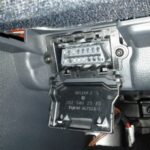The Theft Deterrent Module (TDM) plays a crucial role in your Chevy’s security system, communicating with the Engine Control Module (ECM) to prevent unauthorized starting. Accessing the OBD2 port is essential for diagnostics and programming related to the TDM. This guide provides a detailed overview of the Chevy TDM, its interaction with the OBD2 port, and key information for troubleshooting.
Understanding the Chevy Theft Deterrent Module (TDM)
The TDM is the brain of your Chevy’s anti-theft system. It uses a transponder key with a unique embedded code. When the key is inserted, the TDM energizes the transponder and verifies its code against stored values. If the code is valid, the TDM sends a “start enable” signal to the ECM. If not, a “start disable” signal is sent, preventing the engine from starting. This communication happens via the serial data circuit.
(Example: A standard Chevy ignition with key inserted.)
The Role of the OBD2 Port
The OBD2 (On-Board Diagnostics) port, typically located under the dashboard on the driver’s side, is the gateway to your Chevy’s computer systems. It allows access to diagnostic trouble codes (DTCs) and enables communication with various modules, including the TDM and ECM, using a scan tool. This connection is crucial for troubleshooting starting issues, reprogramming keys, and performing other security-related tasks.
(Example: Common location of the OBD2 port in a vehicle.)
TDM and ECM Interaction Through the OBD2 Port
A scan tool connected to the OBD2 port facilitates communication between a technician and the TDM/ECM. This allows for:
- Retrieving DTCs: Identifying specific issues within the VTD system, such as a faulty key, damaged exciter coil, or communication errors.
- Immobilizer Relearn: Reprogramming the TDM and ECM to recognize new keys or reset the system after component replacement. This often involves a timed procedure using a scan tool and may require connection to a Techline Terminal with specialized software.
- Security System Diagnostics: Testing various components of the VTD system, such as the transponder key, exciter coil, and wiring.
Troubleshooting Common TDM Issues
Common problems related to the TDM include:
- No Start Condition: The engine cranks but doesn’t start. This could be due to an invalid key, a faulty TDM, or a communication issue between the TDM and ECM.
- Security Light Illuminated: A solid or flashing security light indicates a problem with the VTD system.
- Lost Keys: Requires reprogramming the TDM to recognize new keys.
Using a scan tool connected to the Chevy Tdm Obd2 Port allows technicians to diagnose these issues by retrieving DTCs and testing system components.
(Example: A scan tool connected to the OBD2 port for diagnostics.)
Conclusion
The Chevy TDM and its interaction with the OBD2 port are critical for vehicle security and diagnostics. Understanding their function and utilizing a scan tool allows for effective troubleshooting and resolution of common starting and security-related problems. For complex issues or programming procedures, consulting a qualified technician with access to specialized equipment and software is recommended.

